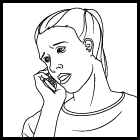The Importance of CPR Training


1. CALL
Check the victim for unresponsiveness. If the person is not responsive and not breathing or not breathing normally. Call 911 and return to the victim. In most locations the emergency dispatcher can assist you with CPR instructions.
 2. PUMP
2. PUMP
If the victim is still not breathing normally, coughing or moving, begin chest compressions. Push down in the center of the chest 2 inches 30 times. Pump hard and fast at the rate of at least 100/minute, faster than once per second.

3. BLOW
Tilt the head back and lift the chin. Pinch nose and cover the mouth with yours and blow until you see the chest rise. Give 2 breaths. Each breath should take 1 second.

CONTINUE WITH 30 PUMPS AND 2 BREATHS UNTIL HELP ARRIVES NOTE: This ratio is the same for one-person & two-person CPR. In two-person CPR the person pumping the chest stops while the other gives mouth-to-mouth breathing.
- Please make sure you attend CPR training course before attempting. They are offered by the American Heart Association (for training courses near you call 1-800-AHAUSA1), the American Red Cross and by many local fire departments.
AeroMD Air Ambulance serves our neighbors throughout the Caribbean and worldwide.
-
“My best case for survival was to be taken off-island.”

Charles Jaquays, AeroMD Patient
-
“You guys saved [my husband's] life.”

Eileen des Jardins, Patient Companion
-
“If it wasn't for [AeroMD], I wouldn't be here today.”

Hayley Rodriguez, AeroMD Patient
